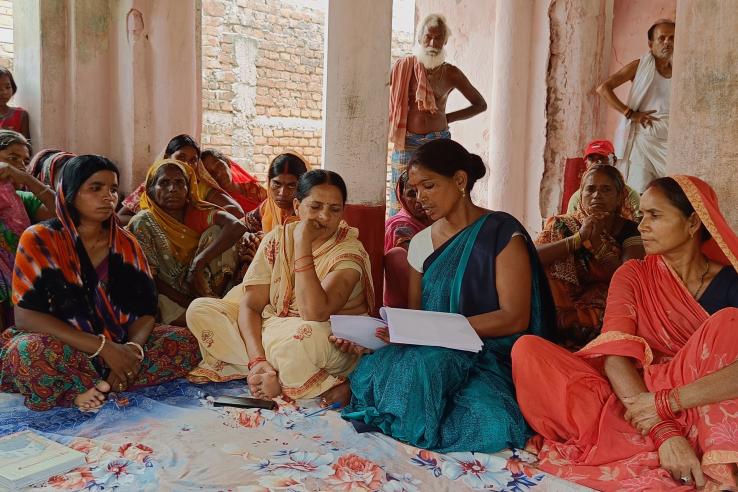
Lessons from the field: How last-mile agents are delivering the largest government-led scale-up of the Graduation Approach

A cadre of 5,000 Master Resource Persons (MRPs) has been working in the Indian state of Bihar to implement the Government of Bihar’s Satat Jeevikoparjan Yojana (SJY), an adaptation of the Graduation Approach.
Poverty in India is a pressing concern as millions continue to grapple with scarcity. The Indian government has been making significant strides to enable people to move out of extreme poverty, but many still struggle. The NITI Aayog’s Multidimensional Poverty Index Progress Report says that over 195,000,000 people in India live in extreme poverty (even though 248,200,000 people have managed to escape extreme poverty in the last nine years). Reaching this population won't be immediate, but a rigorously tested anti-poverty program, currently being scaled up in the eastern Indian state of Bihar, shows promise.
In the state, Master Resource Persons (MRPs), or the frontline workers, have emerged as a powerful driving force in taking the program to the last mile. The Bihar Rural Livelihoods Promotion Society (locally known as JEEViKA) has been working with a cadre of 5,000 MRPs to deliver Satat Jeevikoparjan Yojana (SJY) program to the remotest corners of the state.
SJY is adapted from the Graduation Approach, a comprehensive livelihoods model that has been shown to be effective in putting ultra-poor households on the path to self sufficiency in six countries. In India, a randomized evaluation led by J-PAL Co-Founders Abhijit Banerjee (MIT) and Esther Duflo (MIT) in West Bengal’s Murshidabad district found that the effects of the program persisted even after a decade: The consumption of the ultra-poor households receiving the program remained 18 percent higher than those that did not.
To study the impact of SJY, another evaluation by Abhijit Banerjee, Esther Duflo, Jyotiprasad Mukhopadhyay (IFMR Graduate School of Business), Shagun Sabarwal, and M. R. Sharan (University of Maryland) is currently underway in the state. Meanwhile, the program has reached over 180,000 women-headed households in Bihar, and JEEViKA has now set the target of reaching over 300,000 households.
As SJY expands, J-PAL South Asia has been monitoring its implementation processes and regularly sharing insights with JEEViKA. While NGO Bandhan Konnagar, as technical partner, has been helping JEEViKA develop and adapt the processes to implement SJY. Alongside, a consortium of philanthropic partners have been working to sustain the program.
At the center, J-PAL South Asia has also been advising India’s Ministry of Rural Development (MoRD) on leveraging scientific evidence and data in their decision-making as it pilots Samaveshi Aajeevika (Inclusive Development) program. Launched in 2024, the program is an adaptation of the Graduation Approach and it aims to put rural women on the path to self-sufficiency. Samaveshi Aajeevika is now being piloted in ten states in the country.
Our work with MoRD is a reminder that building long-term, multi-stakeholder partnerships are critical to scaling policy impact. The Alliance for Scaling Policy Impact through Research and Evidence (ASPIRE), jointly set up by J-PAL South Asia and the Veddis Foundation, has been doing just that. It is a coalition of governments, donors and civil society organizations working towards alleviating poverty through scientific evidence and data.
SJY is another example of this collaborative approach in action. It may offer a useful model to reach households experiencing extreme poverty, especially to those implementing organizations and governments looking to harness the power of existing community cadres such as MRPs to scale programs like SJY.
Between 2019 and 2024, J-PAL South Asia conducted over fifteen surveys and the results from a few revealed that nearly 99 percent of participants reported being satisfied with the support offered by MRPs. More recently, the team spoke with MRPs to understand their experience of working on the ground.
In the subsequent sections, we unpack everything we have learned so far. But before that, a quick overview of the roles and responsibilities of MRPs.
Going the last mile with MRPs
MRPs undergo comprehensive training sessions led by JEEViKA. These sessions are designed to help MRPs support their participants in setting up and running their business. Each MRP is assigned 30–35 participants.
After the training, MRPs use their local market insights to help their participants choose an asset, e.g. cows, goats, or supplies for small-scale trade. As the business grows, MRPs coach their participants, and make weekly household visits to assist the participants in documenting their progress. MRPs also help access government schemes and advise participants on the importance of nutrition, hygiene, education and other issues of social concern.
Most MRPs have prior experience working in the community, which include, teaching in schools, raising program awareness, knowledge sharing, etc. Therefore, most of them are quick to acquire specialized skills required for the role.
While their role primarily entails empowering the community they work with, they also develop skills, and some even rise through the ranks.
Lesson #1: Supporting MRPs through continuous training and enabling data-driven decision-making
One of the key lessons that have emerged from the interviews and focus group discussions is that MRPs need continuous training to contribute to SJY expansion.
In JEEViKA’s overall programming, most interventions are delivered to a group. However, under SJY, participants are assisted on an individual basis, which requires a differentiated and specialized approach. MRPs are trained through five, staggered modules:
- Inducting MRPs into the SJY program
- Teaching them about developing business, keeping records and facilitating group meetings
- Training them on diversifying business, and recording asset growth
- Providing refresher training on previous modules
- Mentoring how to support households so they can gradually phase out of the program
The training also equips MRPs to address a range of needs and tackle social, emotional, and economic hurdles faced by the participants. In addition to the five-module mandatory training, need-based refresher training is conducted at the discretion of the state-level teams.
MRPs also learn about the use of technology. It was observed that the adoption of the Management Information System (MIS)—a structured system that collects, processes, and stores data to provide information needed for managing an organization—helped MRPs use smartphones with greater ease, and make decisions based on the data they collected during field visits. MRPs track the progress of their participants and derive insights from the data to identify the specific support each participant needs.
Lesson #2: MRPs are trusted influencers and innovators
MRPs play a multifaceted role that often goes beyond simply facilitating SJY. The participants often reached out to MRPs seeking their guidance on marriage and their children’s education. In some cases, participants affectionately addressed MRPs as bhaiya (Hindi for elder brother), or didi (Hindi for elder sister).
Sometimes, JEEViKA assigns MRPs to participants from the same village councils as them, so they are able to talk to each other using the same regional dialect. This goes a long way in creating an atmosphere of openness, encouraging active participation, and a sense of ownership. And perhaps most importantly—trust. “It is not just about the enterprise, but also about understanding participants on a personal level,” said an MRP. “I discuss their joys, sorrows, and everything in between.”
This not only helps in meeting the program goals but is seen to boost the self-confidence and self-esteem of the participants.
That said, it can sometimes get difficult for MRPs to explain the various program components to participants. To address this, they often have to innovate and improvise. MRPs often organize awareness programs involving local leaders—and sometimes even graduated households. On some occasions, MRPs invited graduated participants to share their success stories during group meetings.
They also find innovative ways to tailor their coaching according to the participants’ needs. One of them is scheduling half-day meetings with Community Resource Persons and the VO leader ahead of their meetings related to SJY.
MRPs perform another vital role: dispelling common misconceptions about SJY. One prevalent assumption is rooted in the SJY’s unique model, which differs from the traditional credit-based model. Evidence from six randomized studies of microcredit in six different countries found that microcredit loans may not be beneficial in the long run for people living in extreme poverty. While it led to an increase in business activity, the effect on average business profits was muted. Researchers have thus concluded that for an average person experiencing poverty, better access to microcredit does not seem to generate the kind of sustained consumption gains that we see with the Graduation Approach program.
Typically, under other programs, VOs require cash repayment. So, when MRPs mention that an asset will be transferred to SJY program participants, people assume they’ll need to repay the amount. This misunderstanding leads to hesitation in accepting the asset. However, the SJY program is designed to specifically cater to the needs of ultra-poor households, meaning participants are not required to repay anything.
Lesson #3: Empowering MRPs through performance-based incentives
JEEViKA routinely updates existing structures within the system to reward MRPs, and create pathways to help them work better.
In April 2022, JEEViKA redesigned its remuneration structure to introduce performance-based incentives. Under this, each MRP received a bonus for every household that graduated, meaning participants who met all the graduation indicators like a monthly income of Rs 5,000 per ultra-poor household, two complete meals per day per household, etc.
As per the revised structure, the honorarium for the MRPs can go up to a maximum value of about Rs 7,500 per month, which includes a bonus along with the fixed amount they receive after submitting monthly progress reports.
Additionally, JEEViKA used insights from process monitoring surveys to recruit more MRPs, to help them efficiently manage their weekly tasks. The intent was primarily to reduce the ratio of households to MRPs, enabling them to focus more on each household.
The way forward
The global success of the Graduation Approach has made it clear that ultra-poor households can move out of extreme poverty with sustained support.
Banerjee, at a recent J-PAL South Asia event with MoRD, said about people living in extreme poverty: “As soon as they get a chance, they begin taking charge of their lives.”
In recent times, there has been an increasing focus on understanding existing systems to improve the efficiency of programs such as SJY and other adaptations of the Graduation Approach.
In SJY’s case, based on our observations so far, MRPs have played an important role in providing the steady and sustained support ultra-poor households need. The upcoming results of the ongoing randomized evaluation of the SJY program in Bihar are expected to provide further insights into the role MRPs, and other community cadres, can play in maximizing the reach of rigorously tested evidence-based social protection programs—and empowering some of the most vulnerable amongst us.
The authors are grateful for the support extended by Abhishek Yadav, Tanay Chanda, and Atul Bharti from the research team at J-PAL South Asia in collating the insights used in this blog, and to Tuba Tasneem for transcribing the interviews. We would also like to thank Dr. Shagun Sabarwal and Dr. Jyotiprasad Mukhopadhyay for their guidance to the team on conducting the case study interviews.
To read the detailed case studies based on the field interviews, please reach out to Parkirama Chowdhury ([email protected]) and Neha Susan Jacob ([email protected]).
Related Content
Graduation approach: Updated insights and best practices at scale
JEEViKA, Bandhan-Konnagar, and J-PAL South Asia launch the Satat Jeevikoparjan Yojana Playbook to double down on the fight against extreme poverty at scale



